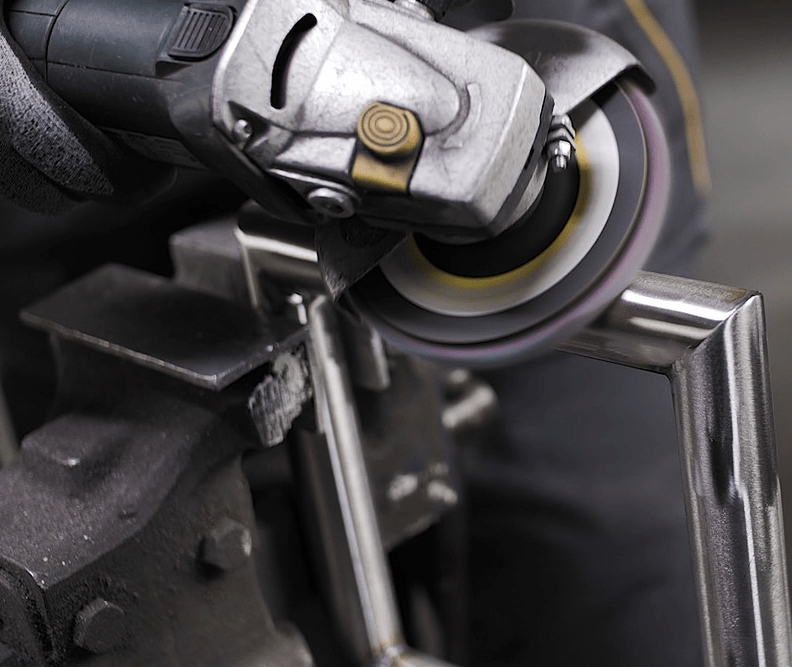Angle grinders are simple yet versatile power tools that can be used to cut, grind, sand and even polish. They get their versatility from the various types of discs they can be paired with. One of those discs are flap discs or wheels which have a number of overlapping particles or flaps that are abrasive.
They are not the same as regular discs and wheels. They were not as common when they first came out at the end of the 70s but flap discs are now the preferred option since they are easier to use. They are also much lighter and require less maintenance than standard discs and offer a superior finish too.
Flap Disc Shapes

Flat
The shape of a flap disc is what determines the type of projects you can take on. A flat drill flap disc, for instance, is made to be used for smooth finishes and for blending on flat surfaces. A flat flap wheel can handle only slight contours since it works best at more shallow angles ranging between 0° and 15°.
Conical
With conical discs, you can remove stock quite aggressively as they work at angles ranging from 15° to 35° which makes them have a shape like that of a spaceship.
Trimmable
If you want more versatility with your abrasive flap wheels then you should go for trimmable ones. They allow you to increase the overlapping of the disc thanks to a trimmable composite backing.
Mini
A mini flap disc comes with a diameter between 5 cm and 7.5 cm which is why they're called mini wheels. This makes them the perfect solution when you need to work in tight spaces and take on hard-to-reach corners.
Angled
Angled discs have curved flaps on the edge of the backing plate. This helps make it easier to use the disc and it makes for a greater flap-to-metal contact. You also get better contouring especially when you're grinding T-joints and for fillet welds.
Flap Disc Density
Type 27
The density of a drill flap disc is strictly related to its shape and therefore a flat flap disc is a type 27 disc. This is a high-density disc that has the same grinding angles as a flat disc.
Type 29
A type 29 disc is a conical disc that has the same grinding angles but it's not as dense as a type 27 disc. A type 29 disc is still considered a high-density disc it just has a more angled profile than a type 27 disc.
Flap Disc Backing Material

Aluminium
The backing material of a drill flap disc is what affects how you'll use it and what you'll use it for. A disc with aluminium backing is best suited for heavy-duty use as aluminium is quite strong yet lightweight.
Phenolic
A disc with a phenolic backing material is not going to be as rigid as one with an aluminium backing plate. Although phenolic material is wear-resistant and able to protect the wheel from scratches it's not made for heavy-duty applications.
Composite
Trimmable abrasive flap wheels are coupled with composite backing plates since they prevent the wheels from marking. Since you can adjust the size of the disc it's important to have a backing material that allows easy access but also protects well enough.
Abrasive Grit Material
Zirconia Alumina
With a flap disc made of zirconia alumina, you're able to remove stock quite aggressively and apply that same effect when edge grinding. This type of grit material is self-sharpening and it can survive through high temperatures as well as high pressure.
Ceramic Alumina
Although not self-sharpening, ceramic alumina lets you work on much tougher materials such as armoured steel, titanium and Inconel. That's because the grains of ceramic alumina fracture as you grind which reveals sharp edges all the time.
Aluminium Oxide
An aluminium oxide flap wheel is a general-purpose disc that is durable and hard. Aluminium oxide discs have a strong cut rate initially but it doesn't stay that away. This is a great option if you want a balance between value for money and performance.
Grit Size
Stock Removal
If you're going to use a flap disc purely for heavy stock removal then you should consider one with a grit size between 36 and 40.
Chamfering
When it comes to chamfering and bevelling edges you're best off with a grit size between 36 and 60 as this way you get a larger range to work with.
Grinding
Blending and weld grinding requires the use of discs with a grit size between 40 and 60 similar to what chamfering() jobs.
Deburring
When you need to deburr and deflash surfaces you should stick to 60 grit discs as they are ideal in this case.
Finishing
For cleaning and finishing a finer grit size is definitely the preferred solution which is why any disc between 80 and 120 grit size is going to get the job done.
